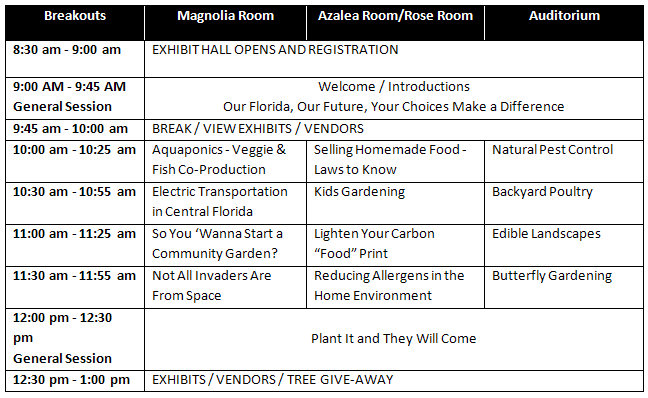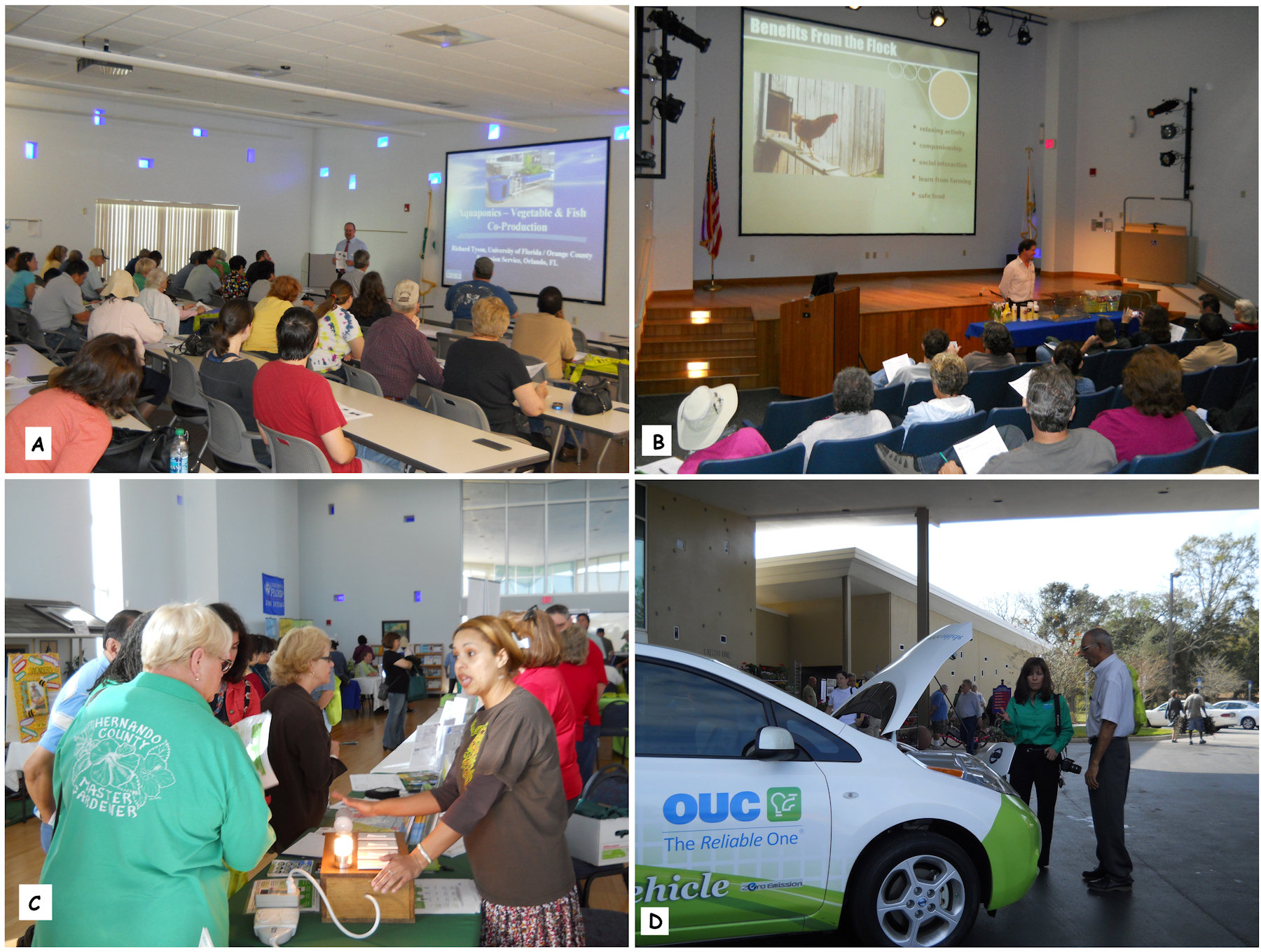Journal of the NACAA
ISSN 2158-9429
Volume 5, Issue 2 - December, 2012
Sustainable Living Educational Expo's Build Teamwork, Community Networks and Adoption of Sustainable Practices
- Tyson, R., County Extension Director, University of Florida Cooperative Extension Service
Felter, E., Commercial Horticulture Agent, University of Florida Cooperative Extension Service
Kennington, M.S., Family and Consumer Sciences Agent, University of Florida Cooperative Extension Service
Mudge, D., Animal Science and Natural Resources Agent, University of Florida Cooperative Extension Service
Pehlke, T., 4-H Youth Development Agent, University of Florida Cooperative Extension Service
Thralls, E., Residential Horticulture Agent, University of Florida Cooperative Extension Service
White, C., Commercial Horticulture Agent, University of Florida Cooperative Extension Service
ABSTRACT
The Eco-Nomic Living Expo was developed as an annual event to counter the economic recession that began in 2008 and hit Orange County, Florida, especially hard. Over 12 % unemployment and record home foreclosures resulted in Extension clientele requesting more sustainable living educational opportunities. Bringing the entire Orange County Extension faculty and staff together for an interdisciplinary sustainability event built Extension personnel camaraderie, promoted community networking partnerships and increased Extension’s reputation as a leader in both rural and urban sustainable development. Program evaluation surveys indicated a considerable willingness to change practices by attendees in order to adopt sustainable living techniques to improve personal and community health, conserve resources and support local food production.
Introduction
The Brundtland Commission of the United Nations defines sustainability as “development that meets the needs of the present without compromising the ability of future generations to meet their own needs” (United Nations General Assembly, 1987). This definition encompasses an overlapping matrix of circles representing environmental, social, and economic factors (Adams, 2006). These factors are well within the scope of Cooperative Extension’s major program areas. They are a good fit for a multidisciplinary educational program addressing the needs surfacing with the economic downturn in Central Florida that began in 2008.
The annual Eco-Nomic Living Expo presented by the Orange County Extension Service, Orlando, FL, combines education, demonstrations, and exhibits to teach sustainable living techniques. These techniques focus clientele and community resources on supporting local food production, reducing non-renewable energy usage and maintaining healthy lifestyle choices. In the long run, this allows communities to save money by reducing health care costs and keeping local resources circulating through local economies. In other words, being able to hand down to future generations a community with a more sustainable future.
Materials and Methods
The Eco-Nomic Living Expo was presented by the Orange County Extension Service, Orlando, FL, the first Saturday of February each year from 2008 – 2012. The Expo combines education, demonstrations, and exhibits to teach sustainable living techniques. The University of Florida Institute of Food and Agricultural Sciences (UF/IFAS) Extension Education Center facilities include 3 classrooms, an auditorium with seating for 180, and an exhibit hall. In addition, demonstration gardens are near the exhibit hall. Major educational program areas were identified and concurrent breakout sessions were scheduled to address clientele and community needs. Figure 1 illustrates the agenda presentation titles and Figure 2 depicts selected activities underway during the 2012 Expo.

Figure 1. Expo Agenda for 2012.

Figure 2. Expo activities from 2012: A) Aquaponics and B) Backyard Poultry breakout sessions, C) Exhibit Hall light bulb energy use demo booth and D) Hybrid and electric vehicle demo.
The Extension faculty and staff were assigned to committees, with committee chairs managing every phase of the Expo: exhibits, registration, speakers, marketing, parking and logistics, and evaluations. A tree give-away at the end of the half-day conference was conducted for those attendees who stayed for the entire Expo and presented tickets indicating that they had filled out and submitted the Expo evaluation survey (2010-2012). Program planning began six months ahead of the event. When the agenda was complete, marketing and advertising began, usually several months ahead of the annual February event. Many non-profits with like-minded missions were allowed free exhibit space (i.e., The Simple Living Institute, Slow Food Orlando and Orlando Utilities). Other exhibitors paid for booth space (Fredrickson Apiaries, Solar Companies) which helped pay for program expenses. General admission was free.
Networking with other organizations to compliment the strengths already present in staff significantly enhanced the program. The Florida Solar Energy Institute provided a speaker on alternative energy and brought solar demonstrations. The Orange County Environmental Protection Division and the Orlando Utilities Commission loaned hybrid and electric cars for display and staffed booths.
Results and Discussion
Each year an average of eighteen exhibit hall booths were present at the annual Expo event by businesses and non-profit organizations promoting sustainable practices and selling locally grown products. Examples were residential solar power companies, Slow Food Orlando, the Native Plant Society, Orlando Utilities, the Simple Living Institute, and for sale vendors such as Fredrickson Apiaries and Verti-Gro Inc. The Expo attendance was 175, 152, 244, 227, and 247 in 2008, 2009, 2010, 2011, and 2012, respectively. A cumulative email list of attendees was established and maintained and used to periodically advertise other Orange County Extension educational programs taking place during the year.
Evaluation surveys during the first two years (Table 1) consisted of mail surveys sent out six months after the Expo event to question attendees about their adoption of sustainable practices taught during the Expo. Significant adoption of certain practices were consistent in both years: using “green” cleaning products, use of Orange County Extension’s reusable shopping bag, changing of air conditioner filters, shutting off irrigation systems during rain periods, purchasing organic or local foods, and setting the thermostat at 78 degrees or higher to conserve energy during warm weather. The survey instrument was changed to an end of program questionnaire for the 2010-2012 Expo events (Table 2) in order to measure a gain in knowledge and capture a larger pool of attendees in the survey. Attendees who turned in surveys at the end of the 4 hour program were given a ticket to redeem two free trees which they could take home immediately and plant in their landscapes.

Table 1. Percent positive responses to questions in post-Expo mailed surveys.z
z95 and 93 surveys mailed 6 months after Expo with 39 and 24 rturned for 2008 and 2009, respectively.

Table 2. Percent positive responses to questions in post-Expo day of event surveys.z
zPercentage of positive survey responses from 125, 110 and 90 Expo program surveys turned in at the end of the
program in 2010, 2011, and 2012, respectively.
The agriculture and horticulture Extension program area topics usually revolved around the need to support, buy from or start your own local agriculture enterprise. Sustainability begins at the local level. Central Florida, like many rapidly urbanizing areas, has a food security problem. There are 5 million people living within 100 miles of Orlando. At any given time, there is only a 30 day supply of food in the warehouses and grocery stores (personal communication, Fred Wilson, Cisco Foods Manager, Ocoee, FL). If there is a natural disaster or other event that prevents trucks and planes from delivering food, it will run out in about 45 days.
Processed food travels over 1,300 miles and fresh produce travels over 1,500 miles before being consumed (Hill, 2008). Eighty percent of the cost of that food is tied up in packaging, transportation, storage, and marketing costs. Many consumers believe it would be healthier and more sustainable to buy locally grown food and are willing to pay more for it (Martinez et al., 2010). When a dollar is spent on locally produced products, it cycles through the local economy with a multiplier effect creating nearly two dollars worth of economic activity (Rahmani, Hodges & Clouser, 2010). This is the result of the same dollar passing through the hands of multiple local businesses to purchase products needed for local consumption. When products are purchased from outside your state or country, most of those dollars leave the local economy to pay for the cost of the product and the handling and transportation costs to get it here. Empirical research has found that expanding local food systems in a community can increase employment and income in that community (Martinez et al., 2010).
In the natural resources program area Expo presentation topics centered around reducing water, fertilizer, and chemical use on farms and landscapes as well as reducing the use of non-renewable and increasing the use of renewable energy resources.
The family and consumer sciences program area presentations focused on healthy lifestyle choices. Each individual’s physical health is a sustainable living issue that is closest to home. The choices we make about what we eat and drink and how we live our lives on a daily basis can have far reaching consequences for each person, their families and the long term sustainability of our communities due to their effects on health care and food costs.
The 4-H Youth Development team arranged for youth to be classroom monitors and introduce speakers while wearing their green 4-H jackets. This provided opportunities for visibility and recruitment. In addition, 4-H Agents and their volunteers captured the Expo days with photographs that were later used in promoting the program.
The EcoNomic Living Expo won several state, regional, and national awards in the areas of Marketing, Community Partnerships, and Environmental Education from the National Association of Family & Consumer Sciences Extension Agents (NEAFCS). The local visibility of Orange County Extension in sustainability education resulted in many partnerships for future programming and invitations to speak at local events such as the Winter Park Harvest Festival where solar hydroponic demonstrations were also displayed. The organization is developing a reputation as a leader in both residential and agricultural sustainable program development. The Extension office was chosen as a site for several electric car charging stations and a solar energy demonstration site by the Orange County Environmental Protection Division due to its reputation and expertise as a sustainable living educational facility.
Summary
Utilizing the talents and resources of the entire Extension faculty and staff to target a multidisciplinary educational program such as sustainable living improves camaraderie, teamwork, and community visibility and networking. Results indicate a considerable adoption of sustainable living practices and knowledge gained by Expo attendees. This concentrated multidisciplinary focus builds the expertise and reputation of the organization as a leader in sustainable program development in both the residential and rural areas and opens opportunities for future partnerships and educational opportunities.
References
Adams, W.M. (2006). The future of sustainability: Re-thinking environment and development in the 21st century. The World Conservation Union, Report of the IUCN Renowned Thinkers Meeting. Retrieved September 21, 2011, from http://cmsdata.iucn.org/downloads/iucn_future_of_sustanability.pdf
Hill, H. (2008). Food miles:background and marketing. ATTRA – National Sustainable Agriculture Information Service. Retrieved November 2, 2011, from https://attra.ncat.org/attra-pub/summaries/summary.php?pub=281
Martinez, S., Hand, M., Da Pra, M., Pollack, S., Ralston, K., Smith, T., Vogel, S., Clark, S., Lohr, L., Low, S., & Newman, C. (2010). Local food systems: concepts, impacts and issues. USDA Economic Research Service Report No. 97. Retrieved August 31, 2012, from http://agmarketing.extension.psu.edu/ComFarmMkt/PDFs/local_food_system.pdf
Rahmani, M., Hodges, A. & Clouser, R.L. (2010). Economic contributions of agriculture, natural resources, and related industries in Florida counties, 2008. Retrieved September 22, 2011, from http://www.fred.ifas.ufl.edu/economic-impact-analysis/pdf/Florida%20Counties.pdf
United Nations General Assembly. (1987). Our Common Future, Chapter 2: Towards Sustainable Development. Report of the World Commission on Environment and Development. Retrieved September 22, 2011, from http://www.un-documents.net/ocf-02.htm
